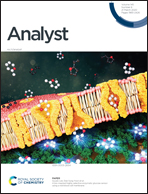The synthesis and bioimaging of a biocompatible hydrogen sulfide fluorescent probe with high sensitivity and selectivity†
Abstract
Hydrogen sulfide (H2S), a well-known poisonous gas, has been recognized as a critical endogenous gas transmitter in the past decade. To provide a quick and efficient detection method for hydrogen sulfide, a novel fluorescent probe DCI-NCN was designed based on an isophoronitrile scaffold featured with the cyanoxy group as the detection group. DCI-NCN shows promising results including high selectivity, high sensitivity, good linear relationship and pH stability in vitro. In addition, good biosystem imaging performance of DCI-NCN is observed in Kunming mice.



 Please wait while we load your content...
Please wait while we load your content...